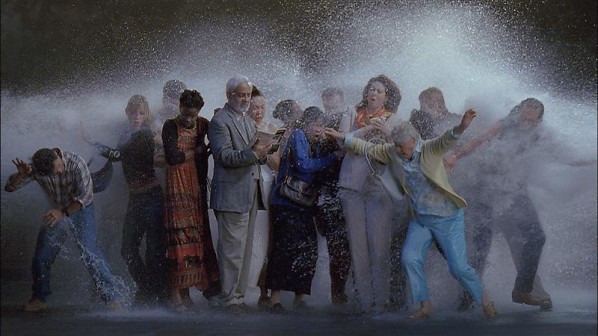
BILL VIOLA-Tempest (Study for The Raft), 2005; Color High-Definition video on flat panel display mounted on wall, 43 x 26 x 4 inches; 109 x 66 x 10.2 cm
From March 9 through May 6, 2012, James Cohan Gallery Shanghai is pleased to present a solo exhibition by internationally acclaimed American artist Bill Viola. For over 35 years Bill Viola has been instrumental in the establishment of video as a vital form of contemporary art, greatly expanding its scale, creative scope and historical reach. He has created video films, architectural video installations, flat screen pieces, sound environments, electronic music performances, as well as works for television broadcast, opera, and sacred spaces. His works focus on universal human experiences—birth, death, the unfolding of consciousness—and have roots in both Eastern and Western art as well as spiritual traditions. They employ state-of-the-art technology and are distinguished by their emotional power, precision and direct simplicity.
On view will be several flat-screen pieces from the Transfigurations series that originated with Ocean Without a Shore and was created for the 15th century Church of San Gallo during the Venice Biennale in 2007. The title, Transfigurations, refers to the moment when a person or an object is transformed not by external means but from within. Viola says "the transformation of the Self, usually provoked by a profound inner revelation or an overwhelming sensation of clarity and fathomless emotion, overcomes the individual until literally a 'new light' dawns on him or her… Some of the most profound human experiences occur at times like these, arising at the outer limits of conscious awareness." In Viola's Transfigurations works, black-and-white images of ghostly figures emerge slowly from total darkness eventually passing through a threshold of water into a world of color and light. Reacting with a range of emotions from surprise, to confusion, fear and anger, often with a desire to linger, the figures are finally drawn back through to the other realm. Viola combines images recorded in grainy analog video using an old surveillance camera with those shot in High-Definition video to bring the viewer to the intersection of obscurity and clarity—from death to life—and back again.The works being shown from the Transfigurations series are The Return (2007), Anika (2008), The Far Shore( 2007), Melina (2008).
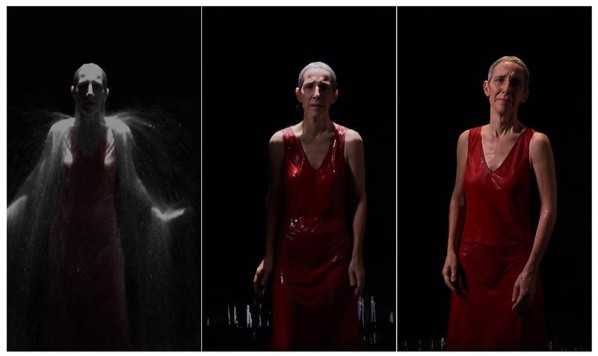
BILL VIOLA-The Return, 2007; Color High-Definition video on plasma display mounted on wall; stereo sound, 47.5 x 28.5 x 4 inches; 120.7 x 72.4 x 10.2 cm
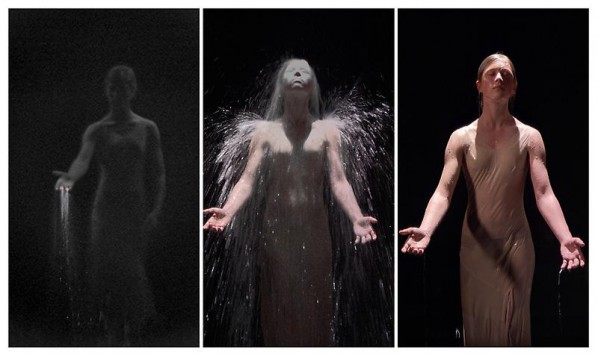
BILL VIOLA-Anika, 2008; Color High-Definition video on LCD panel, 24.8 x 14 x 2.36 inches; 63 x 35.5 x 6 cm
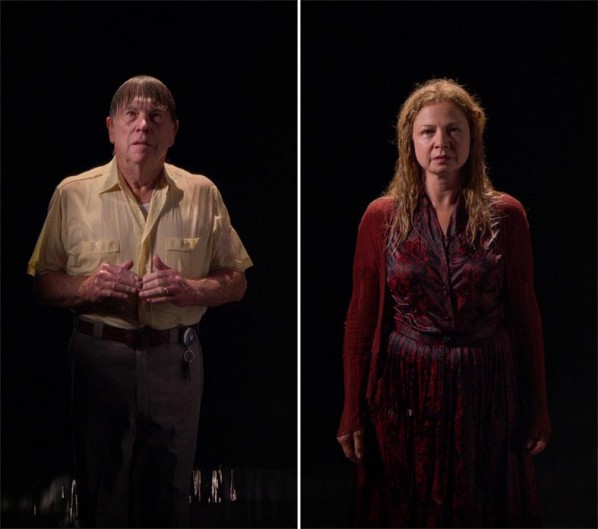
BILL VIOLA- The Far Shore, 2007; Color High-Definition video on LCD panel, 24.8 x 14 x 2.36 inches; 63 x 35.5 x 6 cm
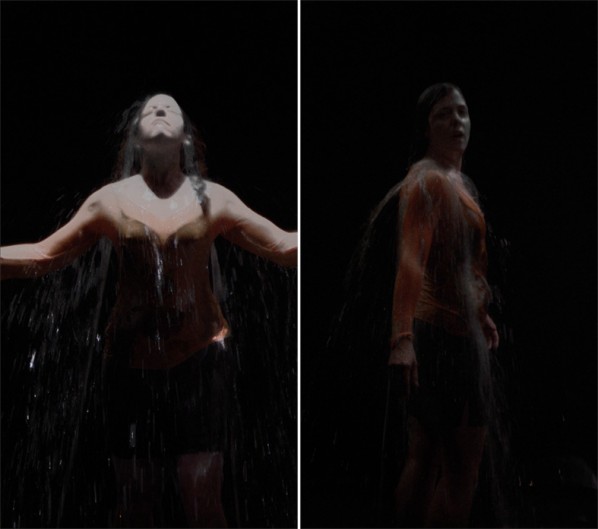
BILL VIOLA-Melina, 2008; Color High-Definition video on LCD panel, 24.8 x 14 x 2.36 inches; 63 x 35.5 x 6 cm
Other works included in this exhibition are Poem A (2005), a triptych, in which images function as a three-part visual poem incorporating themes fundamental to Viola’s oeuvre: elements of earth, air, fire and water. The images are intimate and transform gracefully: A woman alone slowly walks away and disappears into a desert landscape; a tree fluidly morphs into a blood-red and fiery underwater scene; a third screen evolves from an image of moonlight reflecting off the surface of water in which a male figure emerges from the water’s depths, then disappears once more. Also on view will be the work Tempest (Study for the Raft) (2005). Unlike the Transfigurations series that focus on individual figures or couples, Tempest, with its references to both Shakespeare’s play and also the painting The Raft of the Medusa (1818–1819) by French painter Théodore Géricault, is an epic ensemble piece. As described by Bill Viola, “a group of nineteen men and women from a variety of ethnic and economic backgrounds are suddenly struck by a massive onslaught of water with tsunami-like force from a high-pressure hose. Some are immediately knocked over and others brace themselves against the unprovoked deluge. Water flies everywhere as the group clings to each other for survival. Then, as suddenly as it arrived, the water stops, leaving behind a band of suffering, bewildered, and battered individuals. The group slowly recovers as some regain their senses, others weep, and still others remain cowering, while the few with any strength remaining assist those who have fallen. The work is recorded in high-speed film and unfolds in extreme slow motion to reveal subtle nuances of light, color, and individual expressions and gestures of the figures.”
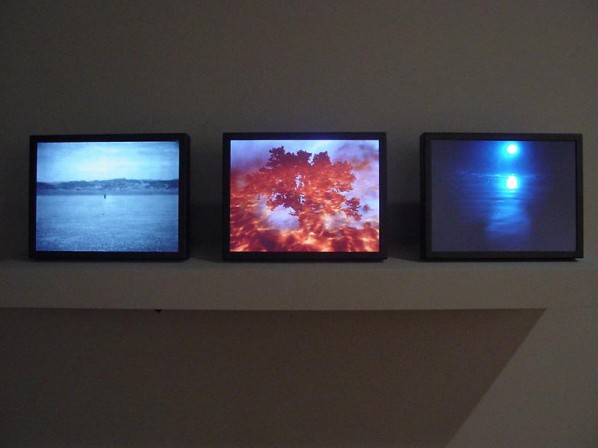
BILL VIOLA-Poem A, 2005; Color video triptych on LCD flat panels mounted on shelf, 14 x 51 x 10 inches; 35.5 x 129.5 x 25.4 cm
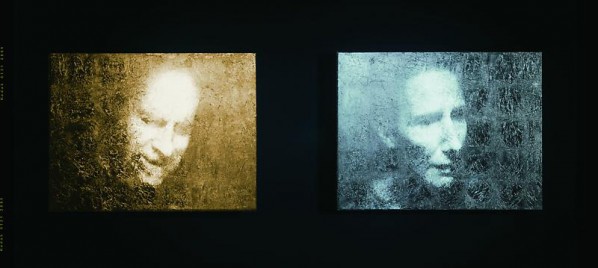
BILL VIOLA-Unspoken(Silver & Gold), 2001; Black-and-white video projected diptych on one gold and one silver-leaf panel mounted on wall, Overall dimensions 24 12 x 76 x 2 14 inches; 62.3 x 193 x 5.
The earliest work in the exhibition is Unspoken (Silver & Gold) (2001), from Viola’s highly acclaimed series The Passions, created after the artist’s work as a visiting scholar at the Getty Research Institute in 1998. Projected on two panels, one gold and one silver, Unspoken focuses on the range of emotional states--joy, fear, sorrow, anger, and rapture--expressed by two people. There is a striking similarity to devotional and sacred paintings of the Middle Ages and the Renaissance as the work becomes an intense examination of the complex human physical and psychological condition, becoming both timeless and eternal because of its universal theme. Drawing further on the art historical and spiritual, the gold background refers directly to Christian icon paintings in which gold symbolizes the holy and celestial, where a person is not merely depicted but is literally present, attaining sacred status. The gold panel also refers to the golden light in the paintings of Rembrandt and especially to the painter’s late self-portraits. The silver panel alludes to Christian mysticism and one of the crucial relics, the Veil of St. Veronica, which is said to carry the mark of Christ’s face. The portrait on the silver panel bears a resemblance to the imprint of the face of Christ visible on the cloth veil. Thus the Unspoken becomes a compelling meditation on worldly suffering and spiritual hope. As Viola has stated, “Art can have a healing function. What is on the screen can be part of a life process that enters the body, and you can take these things and use them.”
Since the early 1970's, Viola's art works have been exhibited worldwide and are included in the collections of international museums and important private collections. Exhibitions include: Bill Viola: Installations and Videotapes, MoMA, NY, 1987; and the travelling exhibition Bill Viola: Unseen Images, 1992-1994, organized by the Kunsthalle Düsseldorf and Kira Perov. Viola represented the U.S. at the 46th Venice Biennale in 1995 with the exhibition Buried Secrets. In 1997 the Whitney Museum organized Bill Viola: A 25-Year Survey that traveled to six museums in the US and Europe. In 2002, Going Forth By Day, a five part video "fresco" cycle was presented at the Deutsche Guggenheim Berlin and the Guggenheim, NY. In 2003, The Passions, originated at the J. Paul Getty Museum, CA and traveled to the National Gallery, London; the Fondacion "La Caixa" in Madrid; and the National Gallery of Australia, Canberra. Other important solo exhibitions have been mounted at the Mori Art Museum in Tokyo in 2006 and at the Zacheta National Gallery of Art, Warsaw in 2007. In 2008, Bill Viola: Visioni interiori, a survey exhibition organized by Kira Perov, was presented in Rome at the Palazzo delle Esposizioni. His exhibition Intimate Works was presented at De Pont, Tilburg, Netherlands in January, 2010.
Viola is the recipient of numerous awards and honors, most recently receiving the prestigious Praemium Imperiale Award in Tokyo in 2011. He received a John D. and Catherine T. MacArthur Foundation Fellowship in 1989; the first Medienkunstpreis in 1993; the Commander of the Order of Arts and Letters by the French Government in 2006; the Eugene McDermott Award in the Arts, MIT in 2009; and the 2009 Catalonia International Prize. In addition to several honorary doctorates, Viola was invited to be a visiting scholar at the Getty Research Institute, Los Angeles in 1998. Bill Viola and Kira Perov, his wife and long-time collaborator, live and work in Long Beach, California.
Location: James Cohan Gallery Shanghai
Artist: Bill VIOLA
Date: 9 Mar - 6 May 2012
Courtesy of Bill Viola and James Gohan Gallery Shanghai.




























